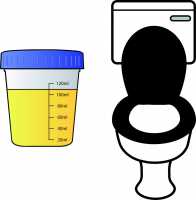
14 Oct Urothelial Carcinoma Can Be Detected By Non-Invasive Urine Test
MedicalResearch.com Interview with:
Chuan-Liang Xu, MD, PhD
Changhai Hospital of Shanghai
MedicalResearch.com: What is the background for this study? What are the main findings?
Response: Patients with urothelial carcinoma usually have to undergo lifelong cystoscopy for surveillance, because it recurred often. Cystoscopy is an examination which inserted a catheter with light and camera into the urethra and inspect the lining of the bladder. Cystoscopy is invasive and uncomfortable for the patients, and also cost a lot of money. Urothelial carcinoma is in direct contact with the urine, just like fish and water, and tumor cells might be flushed out by urine. Traditional method urine cytology is trying to find tumor cells in the urine by cytopathologist, but this method may miss up to 50 to 70% of tumor patient.
So, the main purpose of our study is to establish a new non-invasive, and more accurate method to detect urothelial cancer by analyzing the chromosomal alterations from the urine exfoliated cells, and reduce the use of cystoscopy.
MedicalResearch.com: What should readers take away from your report?
Response: UroCAD assay is a non-invasive approach for diagnosis and surveillance of urothelial carcinomas in clinical practice. Patients with hematuria but did not find the causes, or patients with bladder cancer did not want to undergo frequent, painful and costly cystoscopic examination, they now have a new choice of non-invasive and accurate UroCAD assay. For those suspected with upper tract urothelial cancer, UroCAD can assist image technique and provide more information to urologists
MedicalResearch.com: What recommendations do you have for future research as a result of this work?
Response: Next, we will focus on the efficacy of this method in urothelial cancer surveillance. Frequent recurrence is a significant characteristic of urothelial cancer. Patients after surgery requires frequent cystoscopy to assess for recurrence or residual disease. Most guidelines recommend cystoscopy at 3-month intervals for 2 years, and lifelong surveillance half a year or yearly after that. This caused pain and economic burden to patients and result in poor patient compliance. Thus, we have already initiated a multiple center and single blind clinical trial (NCT04432909) to evaluate the efficacy of UroCAD in disease surveillance. We want to find whether UroCAD can detect residual or recurrent tumor before cystoscopy, and we want to analyze whether the alteration burden of chromosomes is related to the prognosis of tumor.
Similarly, as fluid moves from the prostate through the urethra, it also carries cancer cells from prostate. UroCAD could also be used for high grade prostate cancer screening which has been supported by our preliminary researches. The results will be reported in detail shortly.
Additionally, by analyzing the UTI (Urinary tract infections) patients from current study, we also find that urine carries microbiomes. We can also successfully extract the microbiome information from a UroCAD test. The results will be reported in detail shortly.
Any disclosures? Nothing to disclose.
Citation:
Noninvasive Detection of Urothelial Carcinoma by Cost-effective Low-coverage Whole-genome Sequencing from Urine-Exfoliated Cell DNA
Shuxiong Zeng, Yidie Ying, Naidong Xing, Baiyun Wang, Ziliang Qian, Zunlin Zhou, Zhensheng Zhang, Weidong Xu, Huiqing Wang, Lihe Dai, Li Gao, Tie Zhou, Jiatao Ji and Chuanliang Xu
Clin Cancer Res October 9 2020 DOI: 10.1158/1078-0432.CCR-20-0401
[subscribe]
Last Modified: [last-modified]
The information on MedicalResearch.com is provided for educational purposes only, and is in no way intended to diagnose, cure, or treat any medical or other condition. Always seek the advice of your physician or other qualified health and ask your doctor any questions you may have regarding a medical condition. In addition to all other limitations and disclaimers in this agreement, service provider and its third party providers disclaim any liability or loss in connection with the content provided on this website.
Last Updated on October 14, 2020 by Marie Benz MD FAAD
